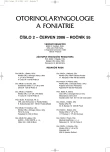Genetic Electrophysiological Background of Perception of Tinnitus in Patients with Cochlear Perception Disorder of Hearing
Authors:
J. Rottenberg; R. Kostřica; M. Žallmann; Michal Jurajda 1
Authors‘ workplace:
Klinika otorinolaryngologie a chirurgie hlavy a krku LF MU a FN u sv. Anny, Brno
; Ústav patologické fyziologie LF MU, Brno
1
Published in:
Otorinolaryngol Foniatr, 55, 2006, No. 2, pp. 96-102.
Category:
Original Article
Overview
Summary:
The disinhibitory feedback hypothesis of the tinnitus generation is based on feedback regulation of neural activity in the ascendent part auditory pathways via inhibition or activation of descendent auditory connections. To support or reject this hypothesis the relationship between markers of disinhibition in AEP and tinnitus manifestation could be studied. Additionally, the differences in genetic background of receptor systems of the auditory pathways having influence to the tinnitus manifestation may establish the site and structure responsible for the tinnitus generation. A group of 105 patients with cochlear sensorineural hearing loss was studied from the standpoints of tinnitus manifestation, BAEP and MLR and analysis of genetic polymorphisms – Taq I polymorphism of DRD2 receptor, 10 intron +101 C/T and 1275 A/G polymorphism of GRIN2a subunit of NMDA receptor, 2664 C/T polymorphism in the GRIN2b subunit of NMDA receptor and CA repeat in gene of GABRß3 subunit of GABAA receptor. Following dependencies were found: the tinnitus manifestation correlated well with the V/III amplitude ratio of BAEP (p<0.001) and PA amplitude of MLR (p<0.001). The tinnitus manifestation differed significantly in dependence to genotype of CA repeat in gene of GABRß3 subunit (p=0.04). Polymorphism 2664 C/T in the GRIN2b subunit of NMDA receptor influenced the electrophysiological markers of disinhibition, but this difference was only marginally significant (min. p=0.07). These results may support the disinhibitory feedback hypothesis of tinnitus generation.
Key words:
tinnitus, BAEP, MLR, disinhibition, genetic polymorphism, GABA-A receptor.
Labels
Audiology Paediatric ENT ENT (Otorhinolaryngology)Article was published in
Otorhinolaryngology and Phoniatrics

2006 Issue 2
Most read in this issue
- Tonsicellectomy in the Cold and Warmth
- Nodular Cervical Metastases of Spinocellular Carcinoma of Oropharynx and Pharynx (Part 2)
- Mucosal Melanomas of the Head and Neck
- Surgical Treatment of Cholesteatoma
